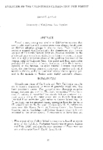- DSpace Home
- →
- Channel Islands
- →
- National Park Service
- →
- California Islands Symposia Documents
- →
- 1st Symposium on the Biology of the California Islands
JavaScript is disabled for your browser. Some features of this site may not work without it.
| dc.contributor.author | Axelrod, Daniel I. | en |
| dc.date.accessioned | 2010-01-13T00:00:04Z | en |
| dc.date.available | 2010-01-13T00:00:04Z | en |
| dc.date.issued | 1965 | en |
| dc.identifier.citation | Axelrod, Daniel I. "Evolution of the Californian Closed-Cone Pine Forest" In: 1st Symposium on the Biology of the California Islands. National Park Service, 1965. 93-149. | en |
| dc.identifier.uri | http://hdl.handle.net/10139/805 | en |
| dc.description.abstract | Fossil closed-cone pines similar to Californian species that now inhabit maritime and interior areas were alreadv established as distinct adaptive groups in Miocene time. Th~ir fossil associates suggest that floristically the closed-cone pine forests are part of the Madro-Tertiary Geoflora. Species ancestral to the pines and their associated endemics evidently represented members of a highly temperate phase of the geoflora that reached the coastal strip in Oligocene time. The pines and their associates probably did not evolve in insular isolation, but in the temperate uplands in the interior. As more extreme climates developed there, the pine forests migrated coastward to survive under mild maritime climate, and also southward where related species persist in the uplands of Mexico under highly temperate climate. | en |
| dc.language.iso | en_US | en |
| dc.publisher | National Park Service | en |
| dc.subject | plant evolution | en |
| dc.subject | california islands | en |
| dc.subject | channel islands | en |
| dc.title | Evolution of the Californian Closed-Cone Pine Forest | en |
| dc.type | Article | en |
Files in this item
The following license files are associated with this item:

